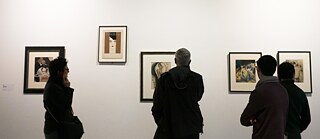Art
“I like to be a choreographer of mistakes”
How does a good artist deal with errors? Illustrator Emanuelle Dufour and performance artist Amitesh Grover chat with Verena Hütter from the Goethe-Institut Washington about how mistakes can be an unexpected force in shaping a work of art. Our chat debate deals with innocent blunders and unforgivable faux pas in various areas of society.
Verena Hütter (15:02):
My name is Verena Hütter. I work for the Goethe-Institut in Washington, DC. I studied art in Karlsruhe (Germany) – so I’m very interested in the topic of mistakes in art.
Amitesh Grover (15:03): My name is Verena Hütter. I work for the Goethe-Institut in Washington, DC. I studied art in Karlsruhe (Germany) – so I’m very interested in the topic of mistakes in art.
Hi, I’m Amitesh Grover. I’m a performer, director, writer, and curator based in New Delhi, India. People often wonder what is it exactly that I do, and with them, I wonder, too.
Emanuelle Dufour (15:03):
It’s a pleasure to meet you both Verena and Amitesh. My name is Emanuelle Dufour and I am a drawing-anthropologist based in Montréal (Quebec, Canada). I am currently involved in various projects in the fields of graphic art (comics) and Indigenous education while also working as Equity, Diversity and Inclusion adviser at College Ahuntsic in Montréal.
Verena Hütter (15:03):
Here’s my first question for you: Emanuelle, you’re based in Montréal. Amitesh, you’re in New Delhi. How do people in your cities react when mistakes are made? Are they furious? Patient?
Emanuelle Dufour (15:03): Here’s my first question for you: Emanuelle, you’re based in Montréal. Amitesh, you’re in New Delhi. How do people in your cities react when mistakes are made? Are they furious? Patient?
I think the answer depends on how you define mistakes.
Verena Hütter (15:03):
Let’s define mistakes as small accidents that happen in a city – traffic, trains, shopping, etc. Imperfections!
Emanuelle Dufour (15:04):Let’s define mistakes as small accidents that happen in a city – traffic, trains, shopping, etc. Imperfections!
People in Montréal are generally quite easy-going and laid-back. So I guess most of the time, they won’t make a big deal out of a minor wrong or mistake if there aren’t any major consequences.
Amitesh Grover (15:05):
It is difficult to define a “mistake” here because it is difficult to come to a consensus about what the “standard” or “commonly understood” or “consensual” way of doing or perceiving things is. There are multiple ways of arriving at or departing from a particular moment in time and space. Traffic in Delhi is mostly horrible, trains are always delayed, and shopping is ordinarily a nightmare because of the crowds. Where should I look for the “mistake”?
Emanuelle Dufour (15:06):
I feel the same way, Amitesh. Before our meeting, I looked up a few formal definitions of the word “mistake” in French and English and I realized I had a different understanding of the concept.
Verena Hütter (15:06):
When we set up this project, we spent days on the question “What is a mistake?” Amitesh, you’re right: a thing can be a mistake for one person while someone else would consider it a blessing.
Amitesh Grover (15:07): When we set up this project, we spent days on the question “What is a mistake?” Amitesh, you’re right: a thing can be a mistake for one person while someone else would consider it a blessing.
How would you define the word differently in French and English, Emanuelle?
Emanuelle Dufour(15:08):
My own understanding was something like an unexpected or unplanned course of events that deviated from the intention.In that way, I am a big fan of mistakes.
Verena Hütter (15:09):
That’s exactly what we agreed on for the project: unintentional is important.
Now let’s talk about art! Both of you are artists. What role do mistakes play in your work?
Amitesh Grover (15:10): That’s exactly what we agreed on for the project: unintentional is important.
Now let’s talk about art! Both of you are artists. What role do mistakes play in your work?
Sometimes, I like to be a choreographer of mistakes in my projects. How can I create conditions that enable mistakes to happen, errors or interruptions to take place? How can I frame an event in such a way that it is open to accidents and the unexpected?
Verena Hütter (15:11):
“Choreographer of mistakes” – that’s great! Can you give an example?
Amitesh Grover (15:11): “Choreographer of mistakes” – that’s great! Can you give an example?
For example, I created a performance project in which I worked as a “fake employee” in one of India’s biggest IT firms for six months. Every day, I went in dressed like a regular employee and worked with 20,000 other employees on the same campus. But while I learnt the job and how to be a good employee, I began planting micro-performances of “uselessness,” which intrigued others around me and affected their work performance in small ways to make them question what was happening.
Emanuelle Dufour (15:12):
WOW! This is fantastic! Love it. I met an Australian guy in the Czech Republic who used to work in the audiovisual field. The company he worked for had created a whole video brand out of mistakes. After struggling for months, trying to offer flawless products to their customers (for instance while transferring Super 8 films to other video devices), his crew finally decided to embrace mistakes and make them their trademark. So from that day on, every single one of their products presented (a minor) imperfection. If a transfer came out too well, they would even add a “mistake” (for example jumping in front of the projection screen). As a young artist traveling on a shoestring for years, this encounter really impacted my own vision and approach.
Verena Hütter (15:15):
What about the role of mistakes in your own work?
Emanuelle Dufour (15:16):What about the role of mistakes in your own work?
Leaving room for mistakes and surprises is crucial in my work. I had always felt a bit off, asymmetrical or crooked by nature: my scenographical plans would always be off by a few degrees, my hair would always be undone, and my clothes full of unexpected holes, etc. So it was kind of a relief to learn in my early 20s, that I could eventually let go and accept organic, unperfect or even random outcomes. Since then, I’ve realized that everything about me and my work (except maybe in my scientific reports) is based on chance.
Amitesh Grover (15:17):
I work with text and body a lot and enjoy mistranslations across languages and “mis-gestures” (my neologism) in cross-cultural communication. For example – the English word “irony” is always mistranslated in Hindi, producing an erroneous understanding of the term, which is ironic indeed. But that raises an interesting question about whether Hindi culture has any familiarity with what irony means if they do not have a word for it.
Verena Hütter (15:18):
Irony cannot be translated – that’s a big source of mistakes.
Emanuelle Dufour (15:19): Irony cannot be translated – that’s a big source of mistakes.
I myself work with ink stains and random shapes. One of my graphic novels is based on a series of encounters and opportunities (most of which are unplanned). I mostly work using collage techniques and an intuitive approach. I never feel as satisfied with my own work when it goes as planned as I do if it comes out of a surprise.
Verena Hütter (15:20):
I agree. But you have to recognize the surprise. My description of an artist: someone who’s able to recognize a mistake during their creative process and then highlights the mistake and moves on from there. An artist turns unintentional mistakes into intentional art. Do you agree?
Emanuelle Dufour (15:20): I agree. But you have to recognize the surprise. My description of an artist: someone who’s able to recognize a mistake during their creative process and then highlights the mistake and moves on from there. An artist turns unintentional mistakes into intentional art. Do you agree?
That is beautiful. And so different from what we are taught in so many schools of art. For a few years, I also tried to infuse my academic work (in anthropology) with these concepts to reconnect with these organic, artistic, and intuitive processes.
Amitesh Grover (15:21):
Yes Verena – as an artist, you have to trust your own sense of mistakes. You have to see life in an error, the fun and playfulness and the mischief of a mistake. You have to let the mistake blossom into its own, to let it take shape, and see how deeply wrong it is. You have to place your trust in it.
Emanuelle Dufour (15:22):
I think this philosophy also applies to life in general. Human societies need to learn to “play” instead of trying to control. We need to loosen up rigidity and leave room. In a way, I feel there is no such thing as an error. There are surprises... and there are wrongs. Major human wrongs. But these wrongs do not usually happen randomly. They are usually rooted in something bigger and deeper.
Amitesh Grover (15:22):
That’s lovely to see the signs and songs of something deeper in mistakes. The design of intention is to control. Intention needs to be torn apart by mistakes. Intention can be quite tyrannical; mistakes sometimes too anarchic. I like to think of it as an artistic duet. It is how I understand the role of “process” and “chance” in creating something as an artist.
Verena Hütter (15:23):
Chance – and also change? Do you want to change things through your art?
Amitesh Grover (15:24): Chance – and also change? Do you want to change things through your art?
Verena – yes, reality is always disappointing.
Emanuelle Dufour (15:25):
I have been working a lot with Indigenous youth for the last few years, mostly in graphic arts. The aim is trying to adjust misconceptions and raise awareness about First Nations’ realities, but also to elicit some type of reflexive and conversational work in society as a whole.
Amitesh Grover (15:26):
I don’t have the hubris of expecting change to take place through my art. I hope that by welcoming what has been excluded, discarded, made invisible, or marginalized, I can invite the “mistakes” back into the system to create small seismic quakes. I worked with traditional mourners for three years to begin talking about ways in which we express, remember, and share loss in our societies.
Emanuelle Dufour (15:27):
Someone said that trying to build a wall without fixing its flaws is useless. I think that art can help point out the holes, but changes have to arise from individual and collective engagement.
Amitesh Grover (15:30):
I also cannot help but think that the idea of a mistake becomes overbearing when the specter of utopia is always lingering nearby.
Emanuelle Dufour (15:31):
What do you consider to be utopia, Amitesh?
Amitesh Grover (15:32):
The idea of a utopia – that promised land that we must get to – is an intriguing way to imagine the idea of future itself.
Emanuelle Dufour (15:35):
What other options are out there? The hope and the aim towards a better land (if actions and engagement come along) seem to me to be the only possible grounds for a better future.
Amitesh Grover (15:38):
Utopia and the idea of catastrophe seem wedded to each other – the entire 20th century is perhaps a testament to their marriage.
Emanuelle Dufour (15:40):
Hahaha, I guess that reveals a paradoxical side of me that would like to start planning a brighter future (that would not be made of major mistakes).
Amitesh Grover (15:42):
Haha, me too!
Verena Hütter (15:45):
I enjoyed talking to you so very much! Thank you! Keep making beautiful mistakes!
Amitesh Grover (15:46): I enjoyed talking to you so very much! Thank you! Keep making beautiful mistakes!
I couldn’t have spent a better evening in dreary Delhi than talking to you two wonderful souls. Thank you for the lovely conversation!
Emanuelle Dufour (15:47):
Thanks to both of you! Wishing you many more awesome mistakes and surprises.





